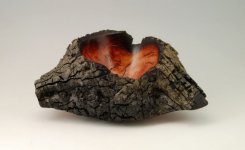I like turning the hard woods. I'll turn every piece of Bradford Pear I can get... it a nice close grain wood and makes nice bowls, pepper mills and such. usually don't let it season for long before I turn it, so maybe why I don't find it so hard....the city (if you can call Tellico Plains a city - population about 800) cut a line of Bradfords some years back... they let me pick up all I could carry in the trunk of my car... before I had the F150.... I think most of it's been turned and sold.
Haven't had any Osage Orange in a while, but last time I turned it didn't have any real problems...'course it was still a little green... I had cut it from a huge OO in my stepfather's cow lot.
Haven't had any large manzanita, but the pen blank I did turn some years back was pretty hard.
Haven't turn any Mallee burl in years, and don't remember how it turned...
Only desert ironwood I've turned was a pen blank about 12-15 years ago... was on a par with the Texas ebony I had... both were pretty woods.... don't remember having much trouble with them.
One that I find to be pretty hard is Persimmon.... they use it to make the golf heads for the woods clubs. Nice close grain and polishes up well. There are two persimmons in the lot across the street that I'm waiting for them to die... they are wild persimmons, and appear to be very slow growing... I've been here 17 years and they don't seem to be getting any bigger... they didn't have many persimmons on them this year.
I had a piece of white oak burl that had lain in my shop for well over 10 years while I decided what I wanted to with it... that gave me a nice work out.
Like Vaughn, I usually start out by sharpening all my bowls gouges before I start... then sometime have to make a couple of trips to the grinder. I recently made a set of carbide tools... I use them mostly as finish tools/scrapers.... rarely use to hollow a bowl. I do have an EWT with a swan neck that I'll use inside a hollow form. But I've been very lazy lately, haven't been to the shop but once since turn of the year... just not in the mood, but need to get in mood as my inventory is getting a little low at the museum.


